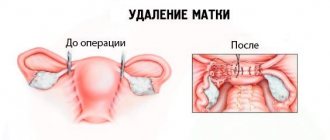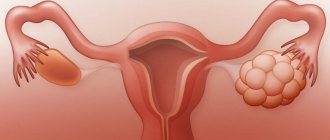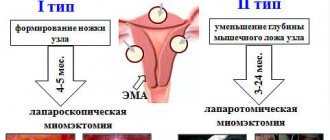Postoperative period
All women who decide to have a hysterectomy should be informed about the possible complications and the length of the recovery period. Emergency surgery is mandatory if there is a threat of metastases spreading to neighboring organs.
In this case, the fallopian tubes, cervix and even part of the vagina are removed along with the uterus, after which the woman will no longer be able to have children.
In other cases, alternative treatment methods are possible, which, although long-term, are no less effective. In any case, the choice here remains with the patient.
The length of a woman’s stay in the hospital after surgery directly depends on the method of its implementation. There are only three methods: abdominal surgery, when the organ is removed through a deep incision in the abdomen, through the vagina, and laparoscopy. The first two methods are the most traumatic and involve the woman being in a hospital under the supervision of gynecologists for ten to fourteen days.
Laparoscopy is a more gentle method in which the risk of postoperative pain is significantly reduced. The patient returns home on the fifth day.
After surgery, women experience severe pain in the abdominal area, which is considered normal, since the removal of an organ cannot take place without consequences. You have to experience many unpleasant moments after recovering from anesthesia, such as: nausea, often accompanied by vomiting, headache, severe thirst and weakness. This condition is due to the fact that, against the background of heavy blood loss and the administration of anesthetics, general intoxication of the body develops.
In the first week, pain after removal of the uterus is especially severe; narcotic analgesics and anti-inflammatory drugs are used to relieve them. To prevent the development of complications in the form of bacterial infection of the wound, antibiotics are prescribed. To avoid the occurrence of blood clots in the first three days, the use of anticoagulants is practiced, as well as intravenous infusion of glucose solution, which will reduce the symptoms of intoxication. To replenish the volume of blood in the body, a transfusion is performed.
The patient is recommended to get up after the operation the very next day, which will prevent the formation of adhesions and, accordingly, pain associated with this process.
How to preserve the uterus and quality of life
Doctor of Medical Sciences, Professor Afanasyev Maxim Stanislavovich, oncologist, surgeon, gynecological oncologist, expert in the treatment of dysplasia and cervical cancer
Historically, the opinion has been established in medicine that the uterus is needed only for bearing a child. Therefore, if a woman does not plan to give birth, she can safely resort to surgery.
https://www.youtube.com/watch?v=GHWRPT5YOdg
Is this really true or not? Why, for example, in March 2015, Angelina Jolie had both ovaries and fallopian tubes removed, but left an “unnecessary” uterus? Let's find out together whether hysterectomy is dangerous. And if it’s dangerous, then with what.
From the surgeon’s point of view, a radical operation solves the issue “at its root”: no organ, no problem. But in fact, surgeons’ recommendations cannot always be perceived as objective. They often do not follow up with patients after discharge, do not conduct examinations six months, a year, 2 years after removal of the uterus, and do not record complaints. Surgeons only operate and rarely face the consequences of the operation, so they often have a false idea about the safety of this operation.
1. (previously absent) pelvic pain of varying intensity,
2. problems with the intestines,
3. urinary incontinence,
4. vaginal prolapse and prolapse,
5. depression and depression, up to serious mental disorders,
6. emotional and physiological problems in relationships with your spouse,
7. Some women who were operated on for severe dysplasia or in situ cancer experienced a recurrence of the disease - damage to the stump area and vaginal vault.
8. fatigue,
9. persistent increase in blood pressure and other serious cardiovascular problems.
The problem is not invented, because according to the Scientific Center for Obstetrics, Gynecology and Perinatology of the Russian Academy of Medical Sciences, various operations to remove the uterus account for from 32 to 38.2% of all abdominal gynecological operations. In Russia, this is about 1,000,000 uterus removed annually!
The problem also has another side. Since all of these complications develop gradually, over the course of a year or several years after surgery, women do not associate the deterioration in their quality of life with the previous operation.
I am writing this material with the goal that you yourself can evaluate all the pros and cons of the operation, weigh the pros and cons, and consciously make your choice.
My practice shows that there are no extra organs. Even for older women, hysterectomy has negative health consequences, and I will discuss them in detail in the second part of this article.
https://www.youtube.com/watch?v=oE_h8FiooFE
I want to reassure those patients who are faced with a difficult choice - whether to agree to have the uterus removed or not. In some cases, hysterectomy can be avoided. Approximately half of those diagnoses that 10 years ago were considered direct indications for surgery are now treated without surgery or without organ removal.
Causes of complications
There are two postoperative periods: early and late, each of them is characterized by its own manifestations.
The appearance of pain in the early postoperative period is associated with the following factors:
- inflammation of scar tissue;
- disturbances in the functioning of the urinary system;
- peritonitis;
- heavy bleeding;
- pulmonary artery thrombosis.
In the late period, the appearance of pain is due to:
- adhesive processes;
- prolapse or prolapse of the vagina;
- development of mastopathy.
Important! After removal of the reproductive organs, hormonal disruption occurs and early menopause develops, which can lead to poor health and pain, the occurrence of which in women is not associated with postoperative complications.
Consequence 2. Ovarian cysts after removal of the uterus
Whether the cervix is left or removed during a hysterectomy depends on the condition of the cervix and the risks associated with retaining it.
If the cervix is left, this is the most favorable situation possible.
On the one hand, due to the preserved ovaries, the hormonal system continues to function more or less normally. But why do they leave the cervix when removing the uterus? Preserving the cervix allows you to maintain the length of the vagina, and after restoration the woman will be able to lead a full sex life.
Removal of the uterus without appendages, but with the cervix, is a more traumatic operation.
By leaving the ovaries, the surgeon allows the woman to maintain normal hormonal levels. If the operation is performed at a young age, the ovaries can avoid menopause and all the associated health consequences.
But even after removal of the uterus without appendages, the anatomical relationship of the organs is disrupted. As a result, their function is impaired.
In addition, complete removal of the uterus, even with preservation of the ovaries, leads to shortening of the vagina. In many cases, this is not critical for sex life. But the anatomy of the organ is different for everyone, and not all women manage to adapt.
This is the most traumatic operation that requires a lot of recovery time.
It requires serious hormonal correction and usually causes all the most severe consequences, especially if performed at the age of 40-50 years - that is, before the onset of natural menopause.
I will tell you more about the most common consequences of hysterectomy below. The most unpleasant thing is that all these consequences are irreversible and practically impossible to correct.
This is a fairly common complication in cases where the ovaries are preserved after removal of the uterus. This is how the negative impact of the operation itself manifests itself.
To understand the nature of the cyst, you must first understand how the ovaries work.
In fact, the cyst is a natural process that occurs every month in the ovary under the influence of hormones and is called a follicular cyst. If the egg is not fertilized, the cyst bursts and menstruation begins.
Now let's see what happens to the ovaries after removal of the uterus.
The uterus itself does not produce hormones. And many surgeons assure that after its removal the hormonal levels will not change. But they forget to say how closely the uterus is connected to other organs. When separating the ovaries from the uterus, the surgeon inevitably disrupts the blood supply and injures them. As a result, the functioning of the ovaries is disrupted, and their hormonal activity decreases.
Unlike the uterus, the ovaries produce hormones. Disturbances in the functioning of the ovaries lead to disruption of hormonal levels and the process of follicle maturation. The cyst does not resolve, but continues to grow.
It takes about 6 months to restore the full functioning of the ovaries and level out hormonal levels. But not always everything ends well, and the enlarged cyst resolves. Often, repeated surgery is required to remove an overgrown cyst - with large tumors there is a risk of rupture and bleeding.
If, several months after removal of the uterus, pain appears in the lower abdomen, which increases over time, you should visit a gynecologist. The most likely reason why the ovary hurts is an overgrown cyst.
The likelihood of developing this complication is only 50% dependent on the skill of the surgeon. Every woman's anatomy is unique. It is not possible to predict the location of the ovaries and their behavior before surgery, so no one can predict the development of a cyst after removal of the uterus.
Complications of the early postoperative period
After undergoing surgery, many women experience pain in the lower abdomen, chest and intestinal area. After removal of the uterus through an incision in the abdominal cavity, the pain is felt especially strongly in the suture area. Acute, nagging pain sensations persist for several days and cover the entire wound surface, radiating to the lumbar region.
If the operation was performed using the transvaginal method, the pain is localized in the lower abdomen, in the groin, spreading to the genitals. The period of complete recovery is two months. Other manifestations of pain indicate complications that have arisen after surgery.
Consequence 6. Orgasm after hysterectomy
Does a woman have an orgasm after a hysterectomy?
On the one hand, all sensitive points - the G-spot and the clitoris - are preserved, and theoretically a woman retains the ability to experience orgasm even after removal of the organ.
But in reality, not every woman gets an orgasm after surgery.
Thus, when the ovaries are removed, the content of sex hormones in the body drops sharply, and many develop sexual coldness. A decrease in the production of sex hormones occurs even if the ovaries are preserved - for many reasons, after surgery, their activity is disrupted.
The best prognosis for orgasms is for those who still have a cervix.
The consequences after removal of the uterus and cervix are manifested in a shortening of the vagina by about a third. Full sexual intercourse often becomes impossible. Research conducted in this area has shown that the cervix is of great importance in achieving vaginal orgasms, and when the cervix is removed, achieving it becomes extremely difficult.
Scar inflammation
The most common complication is inflammation of the scar formed at the site of the soft tissue incision. It is very important to monitor the condition of the postoperative suture, since the occurrence of an inflammatory process can lead to the development of a purulent abscess, which can lead to blood poisoning.
There are several main causes of the pathological process, the most common of which is infection of the wound edges with pathogenic bacteria. Infection can occur both during surgery, due to an insufficient level of sterility, and after it, for example, due to improper treatment of sutures.
This complication does not develop overnight; sometimes it takes several days to manifest itself and is characterized by aching pain not only in the wound area, but throughout the entire peritoneal cavity. The following symptoms also indicate inflammation of scar tissue:
- increased body temperature;
- the appearance of a tumor;
- redness of the skin around the scar;
- acute pain when pressed during examination;
The pain increases many times over if the inflammation is complicated by the formation of pus, in which case the sutures may come apart. Then urgent measures are required, including repeated surgery, and cleansing the wound prevents the development of fatal consequences. To treat the surface suture, the drug curiosin is used, which accelerates healing and prevents the formation of keloid-type scars.
Mastopathy
This topic deserves special attention, since it does not relate to postoperative complications. Many women believe that after removal of the uterus, the entire reproductive system ceases to function, so the breasts cannot hurt. Actually this is not true.
Female sex hormones are produced not by the uterus, but by the ovaries. If they are not removed during surgery, they continue to work as usual. This means that the breast continues to succumb to cyclical changes, which is sometimes accompanied by pain.
In addition, the breast can become inflamed, injured, and ultimately affected by malignant diseases, and this has nothing to do with the removed uterus.
If a woman is concerned about these symptoms, she should immediately consult a doctor. He will determine the cause of the pathological symptoms and prescribe appropriate treatment. In addition, all women, and not just those with a removed uterus, need to regularly examine their breasts by a mammologist for the purpose of early diagnosis of cancer.
Problems urinating
Another complication implicated in pain after surgery is urinary tract dysfunction, which indicates damage to the urethral canal or weakening of the muscles that support the bladder and uterus. The removal of one organ leads to a violation of the integrity of the body, which affects the functioning of other systems.
There are several types of urinary disorders:
- Acute form - this disorder is manifested by frequent, unsuccessful urges to go to the toilet. When the bladder feels full, the woman cannot empty it, and there is heaviness and pain in the lower abdomen.
- Chronic form - a patient who has undergone a hysterectomy has to make incredible efforts to urinate. This is a sure sign that urinary functions are not fully restored. Due to ineffective attempts, painful tension in the abdominal muscles occurs and the risk of suture dehiscence increases.
- Pollakiuria is characterized by frequent urge to go to the toilet, uncontrolled urination or, conversely, its retention. The symptoms are similar to a disease such as cystitis. When urine is released, which can come out drop by drop, the woman feels sharp pain and burning in the urethra.
Reference. To quickly normalize the functions of the genitourinary system after surgery to remove the female reproductive organ, a course of therapeutic exercises using the Kegel method is recommended.
Consequence 5. Sex after hysterectomy
Women who have undergone vaginal hysterectomy should remain in sexual rest for at least 2 months until the internal sutures heal. In all other cases, sex can be had 1-1.5 months after the operation.
Sex life after removal of the uterus undergoes changes.
https://www.youtube.com/watch?v=U5vXd9ZyuX8
In general, women are concerned about vaginal dryness, burning after intercourse, discomfort, and pain. This occurs due to a drop in estrogen levels, which causes the genital mucosa to become thinner and begin to produce less lubricant. Hormonal imbalance reduces libido and interest in sexual life decreases.
- Removal of the uterus and appendages most strongly affects the intimate side of life, since the lack of female hormones leads to frigidity.
- Removal of the uterine body has little effect on intimate life. Vaginal dryness and decreased libido may occur.
- Removal of the uterus and cervix leads to shortening of the vagina, which makes sex difficult after surgery.
Peritonitis
The most dangerous complication of the early postoperative period is considered to be peritonitis - inflammation of the lobes of the abdominal cavity, often spreading to neighboring organs. In this case, sepsis may develop, which poses a threat to the patient’s life. This severe pathology mainly occurs after emergency amputation of the uterus, when there is necrotic damage to the tumor node due to fibroids or a malignant neoplasm.
Characteristic symptoms of peritonitis:
- a sharp rise in temperature to maximum values;
- weakness accompanied by a rapid deterioration in health;
- nagging pain in the area of localization of the lesion, which appears constantly;
- severe headache, aching muscle and joint pain against the background of progressive intoxication of the body;
- increased tension in the walls of the peritoneum, upon palpation, causing unbearable pain.
At the initial stage of development of peritonitis, external changes in the wound surface are observed, the sutures swell, their suppuration begins and the edges diverge. The pain can be felt throughout the entire abdominal area, sometimes it shifts to the side, right or left - it depends on the location of the suppuration; in these cases, the woman cannot accurately indicate the location of its localization. If positive reactions are observed with lesions in the lower abdomen, pain is felt above the pubis.
The appearance of symptoms indicating pathology requires immediate medical attention. A secondary incision is made at the suture site, damaged tissue is cleaned, the peritoneum is washed, and a drainage system is installed. After surgical manipulations and a course of rehabilitation therapy, pain symptoms, as a rule, decrease.
Indications
There is probably no woman who would agree to have a hysterectomy without hesitation. But if in some cases specialists give the patient the right to choose, then sometimes surgery is inevitable. Indications for mandatory hysterectomy include:
- malignant tumor growths in the cervix or on the uterus itself,
- if drug treatment for adenomyosis or endometriosis is ineffective,
- in cases of prolonged uterine bleeding,
- if a benign tumor is detected during menopause or perimenopause,
- if there is severe prolapse or complete prolapse of the uterus and other organs,
- chronic pain caused by pathological changes in the uterus.
In addition to the problems that are observed with varying degrees of severity in all patients during the postoperative period, complications can also appear in the later stages after removal. It has been noticed that 7 out of 10 women after a hysterectomy, after some time, experience a feeling of absent-mindedness and inferiority, and feel the emergence of various fears and emotional depression. In addition to hormonal and psychological complications, many women are bothered by chronic pain in the chest, pelvic area and lower abdomen.
Bleeding
There are two types of complications - external bleeding and internal. The first is manifested by bloody discharge from the genitals or wounds. The greatest danger is the second type, when hemorrhage inside the body leads to a sharp decrease in blood pressure, which can cause fainting. In this case, the aching pain is localized at the site of the amputated organ.
An accurate diagnosis is established using ultrasound (ultrasound). To eliminate bleeding, anticoagulants are administered. If the blood loss is large, repeated surgery and blood transfusion are required to replenish its volume.
Other consequences
Few people know, but after such a complex operation on the female reproductive organs, such a syndrome appears as a symptom of surgical menopause. It manifests itself after 14-20 days and is practically no different in symptoms from natural menopause, only it can occur at any age.
When signs of menopause appear, the following symptoms are observed:
- Sweating;
- Tides;
- Urinary incontinence when laughing or coughing hard;
- Decreased sexual desire;
- Vaginal dryness;
- Emotional swings;
- Depression, mood swings;
- Dry and brittle hair, brittle nails.
To reduce symptoms and adverse effects on the body after surgery, it is necessary to strictly follow the recommendations of the treating specialist.
Pulmonary embolism
PE is a serious complication in which a pulmonary artery is blocked by a detached blood clot that enters the bloodstream. This pathology poses a threat to the life of a woman who has had her uterus removed.
Symptoms of the complication include pain in the chest when taking a deep breath, shortness of breath and rapid heartbeat, and a drop in blood pressure. Upon external examination, you may notice a change in skin color (blue discoloration), which is caused by a lack of oxygen. Blood discharge when coughing is also noticed - hemoptysis.
The patient’s well-being directly depends on the size of the blood clot and its location. If a blood clot enters a small artery, a small area of the lung is affected, which is manifested by spasms and the development of pneumonia. Blockage of a large artery can be fatal.
To prevent thrombophlebitis - the formation of blood clots in the blood vessels of the lower extremities, compression stockings are put on before surgery and blood thinning drugs are administered.
Conclusion
Pain in the composite areas may begin after surgery to remove the uterus and appendages. Due to a decrease in the production of female hormones, patients experience early menopause. This is fraught with changes throughout the body. Joints often suffer due to disturbances in calcium and phosphorus metabolism. Treatment is aimed at maintaining joint function, relieving inflammatory processes and restoring cartilage tissue.
Source vashamatka.ru
Good afternoon, I’m 32 years old, now I had my uterus and ovaries removed when I was 22 years old, and I went through chemotherapy, after which I started having problems with my joints. For 10 years now I’ve been walking with pain in my joints, walking, getting up, sitting down is very difficult









